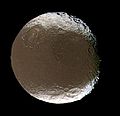Dosya:Iapetus Spins and Tilts.jpg
Iapetus_Spins_and_Tilts.jpg ((361 × 349 piksel, dosya boyutu: 13 KB, MIME tipi: image/jpeg))
Dosya geçmişi
Dosyanın herhangi bir zamandaki hâli için ilgili tarih/saat kısmına tıklayın.
| Tarih/Saat | Küçük resim | Boyutlar | Kullanıcı | Yorum | |
|---|---|---|---|---|---|
| güncel | 02.36, 5 Aralık 2015 |  | 361 × 349 (13 KB) | PlanetUser | Cropped 42 % horizontally and 42 % vertically using CropTool with precise mode. |
| 20.04, 10 Ekim 2006 |  | 618 × 605 (18 KB) | Uwe W. | '''Original Caption Released with Image:''' Saturn's two-faced moon tilts and rotates for Cassini in this mesmerizing movie sequence of images acquired during the spacecraft's close encounter with Iapetus on Nov. 12, 2005. The encounter begins with Cas |
Dosya kullanımı
Bu görüntü dosyasına bağlantısı olan sayfalar:
Küresel dosya kullanımı
Aşağıdaki diğer vikiler bu dosyayı kullanır:
- af.wikipedia.org üzerinde kullanımı
- an.wikipedia.org üzerinde kullanımı
- de.wikipedia.org üzerinde kullanımı
- en.wikipedia.org üzerinde kullanımı
- en.wikiversity.org üzerinde kullanımı
- fr.wikipedia.org üzerinde kullanımı
- ja.wikipedia.org üzerinde kullanımı
- ko.wikipedia.org üzerinde kullanımı
- lt.wikipedia.org üzerinde kullanımı
- lv.wikipedia.org üzerinde kullanımı
- nn.wikipedia.org üzerinde kullanımı
- no.wikipedia.org üzerinde kullanımı
- pt.wikipedia.org üzerinde kullanımı
- ro.wikipedia.org üzerinde kullanımı
- ru.wikipedia.org üzerinde kullanımı
- sco.wikipedia.org üzerinde kullanımı
- sk.wikipedia.org üzerinde kullanımı
- uk.wikipedia.org üzerinde kullanımı
- vi.wikipedia.org üzerinde kullanımı


